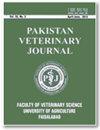Postpartum Cyclicity of Holstein-Friesian Crossbred Cows Shows Relation with Serum Biochemical Profiles during 45-60 Days Postpartum
A. Uddin, M. Atikuzzaman, M. S. Islam, M. Hossain
求助PDF
{"title":"Postpartum Cyclicity of Holstein-Friesian Crossbred Cows Shows Relation with Serum Biochemical Profiles during 45-60 Days Postpartum","authors":"A. Uddin, M. Atikuzzaman, M. S. Islam, M. Hossain","doi":"10.29261/pakvetj/2019.122","DOIUrl":null,"url":null,"abstract":"Received: Revised: Accepted: Published online: September 23, 2019 November 20, 2019 November 22, 2019 December 06, 2019 Reproductive performance of dairy cows is greatly affected by energy, protein and mineral profiles, which is also connected to postpartum anestrus. The present study was conducted during the period from December 2018 to May 2019 on 30 local x Holstein-Friesian crossbred lactating cows with parity 1-5 and body condition score of 2.0-3.5. This study aimed to compare serum glucose, cholesterol, triglycerides, total proteins, urea nitrogen, calcium, phosphorus and magnesium concentrations between anestrus and normal cyclic crossbred cows during 45 to 60 days postpartum. Automated biochemical analyzer was employed to measure these concentrations, using 15 cows in each group. The serum of postpartum anestrus cows contained significantly lower (P<0.05) concentrations of glucose, total proteins, calcium and magnesium compared to normal cyclic cows, while urea nitrogen concentration was significantly increased (P<0.05) in the postpartum anestrus cows. However, concentrations of other serum biochemical metabolites did not differ between cows of the two groups. These results suggest that blood glucose, total proteins, calcium, magnesium and urea nitrogen might have an effect on the cyclicity of Holstein-Friesian crossbred cows during 45 to 60 days postpartum. However, further studies are recommended to explore the underlying mechanism for the role of these metabolites in the cyclicity of postpartum cows. ©2019 PVJ. All rights reserved","PeriodicalId":19845,"journal":{"name":"Pakistan Veterinary Journal","volume":null,"pages":null},"PeriodicalIF":3.8000,"publicationDate":"2020-04-01","publicationTypes":"Journal Article","fieldsOfStudy":null,"isOpenAccess":false,"openAccessPdf":"","citationCount":"0","resultStr":null,"platform":"Semanticscholar","paperid":null,"PeriodicalName":"Pakistan Veterinary Journal","FirstCategoryId":"97","ListUrlMain":"https://doi.org/10.29261/pakvetj/2019.122","RegionNum":3,"RegionCategory":"农林科学","ArticlePicture":[],"TitleCN":null,"AbstractTextCN":null,"PMCID":null,"EPubDate":"","PubModel":"","JCR":"Q1","JCRName":"VETERINARY SCIENCES","Score":null,"Total":0}
引用次数: 0
引用
批量引用
Abstract
Received: Revised: Accepted: Published online: September 23, 2019 November 20, 2019 November 22, 2019 December 06, 2019 Reproductive performance of dairy cows is greatly affected by energy, protein and mineral profiles, which is also connected to postpartum anestrus. The present study was conducted during the period from December 2018 to May 2019 on 30 local x Holstein-Friesian crossbred lactating cows with parity 1-5 and body condition score of 2.0-3.5. This study aimed to compare serum glucose, cholesterol, triglycerides, total proteins, urea nitrogen, calcium, phosphorus and magnesium concentrations between anestrus and normal cyclic crossbred cows during 45 to 60 days postpartum. Automated biochemical analyzer was employed to measure these concentrations, using 15 cows in each group. The serum of postpartum anestrus cows contained significantly lower (P<0.05) concentrations of glucose, total proteins, calcium and magnesium compared to normal cyclic cows, while urea nitrogen concentration was significantly increased (P<0.05) in the postpartum anestrus cows. However, concentrations of other serum biochemical metabolites did not differ between cows of the two groups. These results suggest that blood glucose, total proteins, calcium, magnesium and urea nitrogen might have an effect on the cyclicity of Holstein-Friesian crossbred cows during 45 to 60 days postpartum. However, further studies are recommended to explore the underlying mechanism for the role of these metabolites in the cyclicity of postpartum cows. ©2019 PVJ. All rights reserved
荷母杂交奶牛产后周期与产后45 ~ 60 d血清生化指标的关系
接收日期:修订日期:接受日期:在线发布日期:2019年9月23日2019年11月20日2019年十一月22日2019年12月06日奶牛的繁殖性能受能量、蛋白质和矿物质含量的影响很大,这也与产后麻醉有关。本研究于2018年12月至2019年5月期间对30头产程为1-5、身体状况评分为2.0-3.5的当地x荷斯坦-弗里斯杂交泌乳奶牛进行。本研究旨在比较产后45至60天内无妊娠期和正常周期杂交奶牛的血糖、胆固醇、甘油三酯、总蛋白、尿素氮、钙、磷和镁浓度。使用自动生化分析仪测量这些浓度,每组使用15头奶牛。与正常周期奶牛相比,产后无挤压奶牛血清中葡萄糖、总蛋白、钙和镁的浓度显著降低(P<0.05),而尿素氮的浓度显著升高(P<0.05)。然而,其他血清生化代谢产物的浓度在两组奶牛之间没有差异。这些结果表明,血糖、总蛋白、钙、镁和尿素氮可能对荷斯坦-弗里斯杂交奶牛产后45至60天的周期性产生影响。然而,建议进行进一步的研究,以探索这些代谢产物在产后奶牛周期性中作用的潜在机制。©2019 PVJ。保留所有权利
本文章由计算机程序翻译,如有差异,请以英文原文为准。


